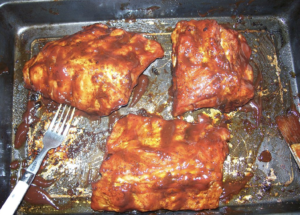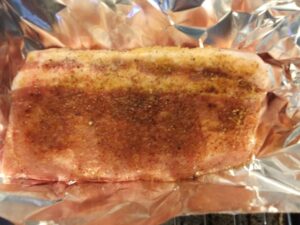Do NOT make “fall-off-the-bone” ribs. FOTB ribs are overcooked and slightly dry – at a BBQ competition, judges will disqualify them and not even taste them if they don’t pass the “tug test.” Good ribs require a slight tug to pull off the bone. If you have to tear the ribs off the bone, they’re undercooked. If they fall off the bone, they’re overcooked.
The good news is, you don’t need a smoker or expensive barbecue pit to make tender, delicious ribs.
Using a low, slow cooking method, you can make tender ribs in your oven or on the grill, using your favorite spices or barbecue sauce. A few basics will help you create succulent ribs whether you grill or bake.
Choosing Ribs for Grilling
You can choose from a variety of ribs that give you different flavor profiles and textures. Baby back ribs are the most common pork ribs. Spare ribs come from the side of a pig and are meatier and fattier than baby backs. Country style pork ribs are actually not ribs, but are thin strips of meat cut from the butt of pork and often prepared like ribs.
Beef back ribs are thick and meaty, while beef short ribs and plate ribs are tougher and take longer to cook. You can get ribs from other animals, such as lamb or goat, but baby back pork ribs and beef back ribs are the two most common barbecued and the ones judged in most competitions.
BBQ Ribs Preparation Tips
If you want healthier ribs, you can trim the fat from them before cooking, but most cooks prefer to use the fat in ribs to make them more tender. Serious rib makers place ribs in a smoker or barbecue with the fattiest part on top so the fat melts into the meat. If you’re going to trim your ribs, trim the ribs when they are cold so it’s easier to cut the congealed fat.
Turn the ribs over to see if they have a thin, white membrane on the bottom and remove this with a knife before you begin seasoning your meat. Let the meat get to room temperature before you start cooking it. This will help the meat cook evenly. Prepare a dry rub with basic seasonings such as salt, pepper, garlic powder, paprika, cumin, brown sugar and cayenne pepper.
Rub the spice mix deeply into the meat, getting it in any cracks or crevices. You can also use a wet sauce, if you prefer. Many cooks will start the meat with a dry rub, then add sauce toward the end of the process. Some start the ribs covered in a wet sauce.
Close the foil – you can add some liquid to help make the ribs more tender. I add a small amount of apple juice.
Barbecue Ribs Cooking Times
There are no exact “best” times for cooking ribs. Instead, cooks look at the tenderness of the rib to determine if it’s done. One way to check if baby back ribs are done is to hold the rack at one end with a tong. If the ribs bend to the point that they are about to break, they are done. You should see them start to crack between the ribs. Another way to check ribs is to hold two adjacent ribs and slowly twist them. If they tear apart easily, with just a little resistance, they are done.
Alton Brown recommends cooking baby back ribs at 225 degrees for 2.5 hours. He finishes his ribs by saucing them and putting them under the broiler for just 30 seconds.
The thicker the ribs, the longer they will take to cook. Count on at least two hours for baby backs and longer for others, depending on how tightly you have them packed in your foil or pan. Do not check them frequently, since this will release the steam and moisture that’s built up in the foil, or heat from the grill.
Cooking Ribs in the Oven
When cooking ribs in an oven, use a low temperature, as low as 225 degrees F, and seal the ribs in aluminum foil. You can place the ribs directly on a sheet of foil, wrapping it around the entire rack of ribs, or you can place the meat in a baking pan, then cover the pan with foil.
Using the pan method, you can place the ribs on a rack inside the pan and add water to the bottom of the pan to create steam and add more moisture to the meat. To add a smoky flavor, add wood chips to the water. You do not need to turn your meat, but can, if you wish, especially if your oven doesn’t heat evenly.
If you are using a wet sauce, remove the ribs from the oven during the last 30 minutes of cooking and apply another coating of your sauce.
Cooking Ribs on a Grill
If you’re using a grill to cook your ribs, it’s better to use it as a barbecue. What’s the difference? Grilling means direct heat (putting the meat above the coals), while barbecuing means indirect heat (putting the meat to the side of the coals).
When grilling ribs, it’s best not to put the ribs directly over coals because this will cook the outside faster than the inside, and possibly burn the meat, depending on whether or not you can control the heat source. The indirect method of cooking ribs will allow you to cook them slower and make them more tender.
Using a grill allows you to add more smoke than oven cooking. You can place wet wood chips directly on charcoals or place the chips in a pan, keeping the pan filled with water or apple juice during the cooking process. Apple, cherry and hickory are good choices for wood chips.
Cook the ribs with a lid on the grill, letting some smoke escape through a vent. Don’t remove the lid from the grill to keep checking on the ribs except toward the end to turn and sauce the ribs.
Additional Resources

